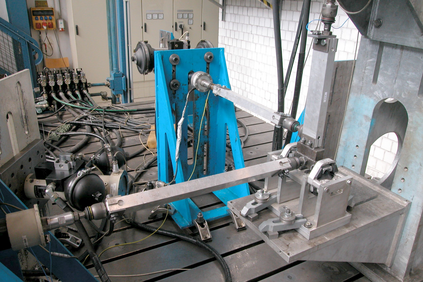Modern Internet of Things solutions are used in a variety of different areas, ranging from connected vehicles and healthcare to industrial applications. They rely on a large amount of interconnected sensors, which can lead to both technical and economical challenges. Virtual sensing techniques aim to reduce the number of physical sensors in a system by using data from available measurements to estimate additional unknown quantities of interest. Successful model-based solutions include Kalman filters or the combination of finite element models and modal analysis, while many data-driven methods rely on machine learning algorithms. The presented hybrid virtual sensing approach combines Long Short-Term Memory networks with frequency response function models in order to estimate the behavior of non-linear dynamic systems with multiple input and output channels. Network training and prediction make use of short signal subsequences, which are later recombined by applying a windowing technique. The frequency response function model acts as a baseline estimate which perfectly captures linear dynamic systems and is augmented by the non-linear Long Short-Term Memory network following two different hybrid modeling strategies. The approach is tested using a non-linear experimental dataset, which results from measurements of a three-component servo-hydraulic fatigue test bench. A variety of metrics in time and frequency domains, as well as fatigue strength under variable amplitudes are used to evaluate the approximation quality of the proposed method. In addition to virtual sensing, the algorithm is also applied to a forward prediction task. Synthetic data are used in a separate study to estimate the prediction quality on datasets of different size.
翻译:现代事物互联网解决方案在不同领域使用,从连通车辆和保健到工业应用等不同领域。它们依赖大量相互关联的传感器,这可能导致技术和经济挑战。虚拟遥感技术的目的是利用现有测量数据来估计更多未知兴趣的数量,以减少系统中的物理传感器的数量。成功的模型响应功能包括Kalman过滤器或有限元素模型和模式分析的组合,而许多数据驱动方法则依赖于机器学习算法。介绍的混合虚拟遥感方法将长期短期记忆网络与频率响应功能模型相结合,以便估计具有多种输入和输出渠道的非线性动态系统的行为。网络培训和预测使用短信号子序列,这些子序列后来通过应用窗口技术重新组合。频率响应模型作为基线估计,完全捕捉线性动态系统或由非线性长期内存网络根据两种不同的混合模型计算法加以扩展。该方法使用非线性实验数据集进行测试,通过测量具有多种输入多个输入输入和输出渠道的非线性动态动态动态动态动态动态系统的行为。网络培训和预测后,网络培训和预测使用了短性信号后继后通过应用窗口技术重新组合式的系统。 频率反应模型是用于数据前向前向前变变变变变变变变变变变变变变变变的系统,在数据变变变变变变变变变变变变变的模型中测算法。A的模型,在使用了数据变变变变变变变变变变变变变变变变变变变变变变变变变变变的模型。








